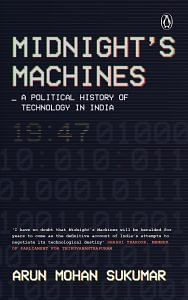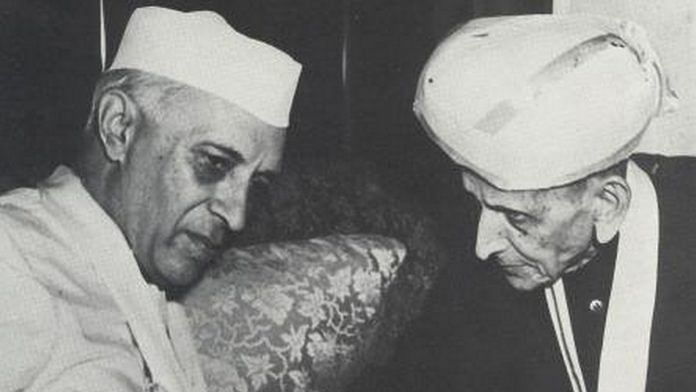Long before Jawaharlal Nehru conjured up visions of ‘temples’ for modern India, Visvesvaraya had already built one. As the chief engineer of Mysore, he conceived and supervised the construction of the Krishna Raja Sagara Dam on the Cauvery, India’s largest river valley project at the time. The project was by no means a cakewalk: the dam’s construction required the approval of the Maharaja of Mysore, Krishna Raja Wadiyar, his diwan, Ananda Rao, and officials of the British empire, including Lord Hardinge, the viceroy, and his resident in Mysore, Sir Hugh Daly. Above all, it had to secure the cooperation of the Madras Presidency, which had only a few years before objected to similar plans for a reservoir by Capt. Nicholas Dawes, Visvesvaraya’s predecessor. The whole enterprise was politically fraught and financially overwhelming: at one point Visvesvaraya threatened to quit if the Maharaja did not approve the dam, as well as other pending projects. The king relented. What made this skilled engineer a powerful technocrat, and why did his ideas bite the dust in independent India?
Visvesvaraya’s aversion to politics proved his greatest asset, but it was also responsible for his eventual undoing. He was fortunate to have lived and worked in one of the richest and best-administered kingdoms in colonial India, which gave him considerable resources and the political patronage needed to pursue grand projects—the KRS Dam, the Mysore Iron and Steel Works, Mysore University, the Bank of Mysore, etc. As the diwan of Mysore between 1912 and 1918, Visvesvaraya maintained excellent relations with officials of the Raj, and indeed, was loyal to the empire throughout its existence. He stood in solidarity, as many freedom fighters did, with the Allied cause during the First World War. But if Mohandas Gandhi supported the war to strengthen India’s claim for self-rule, Visvesvaraya did it out of a sense of genuine sympathy and devotion to the British crown.
The war had ratcheted up the cost of importing machinery to Mysore, and disrupted industrial supply chains: Visvesvaraya was rooting for a British victory because he saw India’s economic future tied to it. He hoped Mysore’s own contributions—the kingdom sent an Imperial Service Regiment to the battlefield — would also persuade the colonial administration to see the Maharaja’s developmental schemes in a kinder light.
‘Swaraj’, to Visvesvaraya, was a more robust form of provincial autonomy that would help him marshal financial resources better for Mysore’s industrial growth. But this strategy of rapprochement with British officialdom was not always successful. When Visvesvaraya tried later to bring Chrysler Corporation to the kingdom to set up an automobile factory, the Government of India objected and killed the project, fearful of competition from American business.
Beyond immediate considerations, what prompted Visvesvaraya, a public administrator attuned better than most to the plight of ordinary Indians, to take a rosy view of colonial rule? To begin with, he believed the rapid industrialization — and through it, the social upliftment — of India would only be possible if the developed world shared its technologies with it. Visvesvaraya foresaw a future in which Europeans and Indians intermingled socially and commercially, and knowledge was freely shared between the West and East.
He harboured none of the romantic notions that Nehru and Gandhi associated with rural life — ‘depth of squalor and degradation’, he called it — and believed India’s future lay in its cities. Visvesvaraya looked to the iconic cities of the West, and spoke of their towering skyscrapers with the same admiration he reserved for the great temples atop hillocks around Mysore and Hampi. While others saw colonial rule as a shackle on India’s freedom, he saw it as a leg up: India’s gateway to Western-style modernity.
Also read: Bharat Ratna Sir M. Visvesvaraya, the visionary engineer who transformed India
The first foreign country Visvesvaraya visited was Meiji Japan, and he came to nurse a lifelong admiration for its model of development. What impressed him was not just the growth of Japan’s economy within a short span of time, but also the homogenous effects of industrialization. The Japanese seemed to be advancing together as a nation, and the benefits of technological innovation and improved education were accessible to all. The Meiji example confirmed Visvesvaraya’s belief that training, coupled with technical knowledge and access to machinery, would be sufficient to modernize India.
A quintessentially technocratic view, this also aligned with Visvesvaraya’s indifference towards politics — he had an almost pathological hatred of socialism and communism, thinking these ideologies to be nothing but attempts at misleading a disaffected population (to be sure, he was no votary of free markets either.
Visvesvaraya pitched for greater state investment in large-scale industries and public goods like health and education, and support for local entrepreneurs capable of delivering ‘last-mile’, consumer goods better than the government. This view increasingly reflects the bipartisan economic consensus of post-1991 India).
His belief in the ‘equalizing’ effect of technology and technical education led Visvesvaraya to some progressive positions. He backed the education of girls and women, but only because he felt their economic contribution could not be unlocked if they were illiterate.
That the efficient division of labour was his primary concern is evidenced by Visvesvaraya’s batting for separate curricula — ‘training in the modern methods of housekeeping’— for girls’ education.
He viewed marriages between ‘allied castes’ as an economic solution to dowry demands. A ‘wider choice of suitable partners’ could address the scarcity of supply among eligible brides of the same caste.
Naturally, he also criticized extravagant spending at weddings, deeming them wasteful expenditure. Visvesvaraya dismissed caste- based taboos around overseas travel: for the nation to progress, its citizens had to be trained abroad in the most advanced universities and factories. This was a man who sincerely believed the individual to be the fundamental unit of economic activity, and a cog in the machine-driven economy. Therefore, it should surprise no one that he was a relentless advocate for longer working hours. Slackness was a problem with Indians, he said, and the solution was less holidays.
Visvesvaraya’s equation of man with machine — as a system that could be improved with use and scientific knowledge — made him blind to social cleavages. It led him to break ranks with Madan Mohan Malaviya on the issue of denominational universities. While Visvesvaraya saw religion as a ‘moral and disciplining force’ much like Malaviya, and commended institutions such as the Benaras Hindu University and Aligarh Muslim University for their public service, he was sceptical of their ability to modernize society. ‘The attempt to develop religious sentiment through the University, I fear, would end in failure,’ he said. The emphasis of Eastern religions on karma and kismet, he worried, would lead to a nation of fatalists, disinclined to base their future on economic considerations.
Also read: Blame British, not Nehru for India’s ‘damaging’ socialist stand on economy after Independence
***
Repelled by the dominant political sensibilities that girded the freedom movement, Visvesvaraya refused to bring his experience to bear on the developmental trajectory of independent India. He ceded the chairmanship of the National Planning Committee to Nehru, and sensing the direction of the NPC, stopped attending meetings after its second session. Could Visvesvaraya have provided the necessary correctives to Gandhian views on technology (both men shared a cordial and respectful relationship)?
Although the erstwhile diwan was no mass leader like the Mahatma, he could have, health permitting, been a technocrat-at-large for the new Prime Minister, supervising national projects. But Nehru allowed democratic politics to colour his view of technology and the model of technological advancement for India, and Visvesvaraya would have none of it.
 This excerpt from Midnight’s Machines: A Political History of Technology in India by Arun Mohan Sukumar has been published with permission from Penguin Viking.
This excerpt from Midnight’s Machines: A Political History of Technology in India by Arun Mohan Sukumar has been published with permission from Penguin Viking.




Nothing new in this plot, give credit to one class for all the development work to show they are the only ones who have built this nation. Sir MV worked in Mysore state for only eight years -two years as Chief engineer and another seven years as Dewan. In 1909 Vishweshwaraih joined the Mysore kingdom as chief engineer. The construction of KRs had already begun and one chief engineer who had planned KRS got retired. The second chief engineer got drowned while trying to save a construction worker at the dam site who was drowning in the river. In this way, Vishweshwaraih was the third Chief Engineer involved in the construction of KRS. After Vishweshwaraiah was promoted as Dewan fourth engineer was appointed. In 1918 he resigned from service and the dam was completed in 1932. So vishweshwaraiah was one of the many chief engineers involved in the construction of KRS. During the construction of KRS, there was a shortage of money for which Maharani gave her all ornaments and precious things which were sold in Bombay, and construction was continued. Sri Nalwad Krishnsraja wodeyar who ruled Mysore kingdom for more than 40 years was the real architect of Modern Mysore.
An analogy to this is Chanakya /Chandra Gupta Mourya and Ramdas /Shivaji Maharaj,Puranas written by one class is replete with morphing the real architects with imposters.
Sir Raja Chandra is correct. It is a total false dam fabrication story. Karnataka people should know the truth.
The Maharaja envisioned the KRS dam project, along with his Engoneer Dawes. He also sacrificed almost all his family jewellery to finance the Project.
All credit goes to the Maharaja.
Regarding, the US, motor company, Vishweswariya and Misra wanted it to be a “monopoly” (?) and not a open license tender for motor companies to be fairly selected.
The Maharaja felt something amiss ,underhand, in these two people joining hands to champion the cause of this one motor company.
In fact both called on the Maharaja to press their demands citing public benefit.
Rightly the Maharaja even refused to meet them, but sent only his Personal Secretary Sir James Todhunter, who met them, turning down their request, and sent them packing.
Something fishy about it, was most obvious.
The Maharaja for the loving welfare of his people, had to be careful of the personal ambitions of his own appointed Dewans, and rightly kept them in their place.
Visweswariya finally was forced out by self resignation, due also to only promoting a upper class /caste.
Gandhiji and all India found Krishnaraja a true Ramyarajya rule. For these reasons.
Media forget the true facts, and indulge in flights of ill gotten facts ,fooling its viewers.
Long before Visvesvaraya had done his diploma, Mysore had started generating electricity by constructing a Hydro electric generating station in Island of Sivasamudram which then belonged to Madras Presidency and supplying to Kolar Gold Fields by erecting Transmission lines which was then considered one of the longest in the world ! Vani Vilasa Sagara dam near Hiiriyur Taluk in Chitradurga district was the first modern dam constructed to harness rain water in Mysore kingdom ! Long before in 1645, Mysore King Ranadhira kanteerava Narasimaharaja Wodeyar constructed a Acqua duct across river cauvery to take ist won water for irrigation purposes from the Banagara Doddai Nala which is the oldest extant such engineering work in the world.
Much before UOM was established mysore had assisted establishing of a pioneering Indian Institute of Science in Banaglore which is still the best such institute in the country and Maharaja was also the first chancellor of BHU before he became chancellor of UOM. An Industry like Bhadarvathi Iron works would never have been permitted in today’s India as it was environmental catastrophe and a financial blunder !
So wonder what the author is trying to highlight !